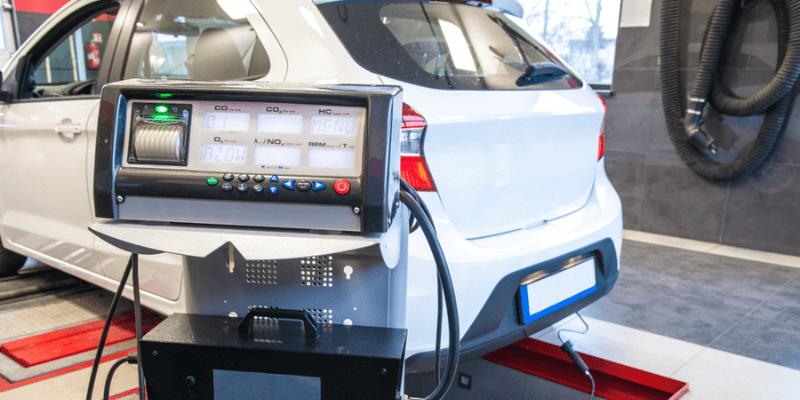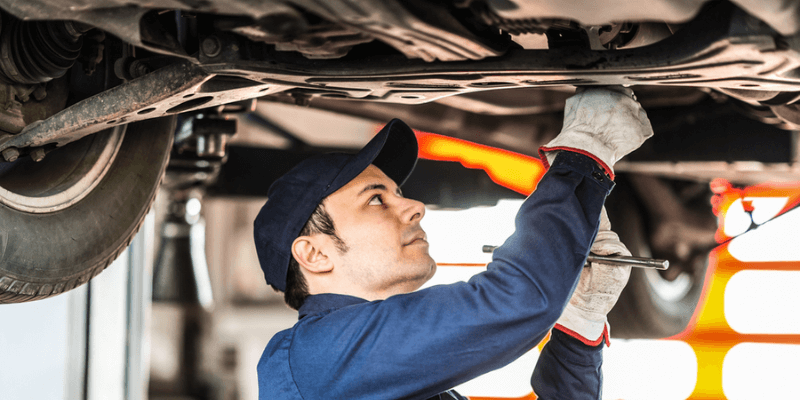 Swipe for more categories
Swipe for more categories 
Vehicle Emissions Testing: Why it Matters and What You Should Know
Vehicle Emissions Testing: Why it Matters and What You Should Know
When your vehicle’s inspection sticker needs to be renewed, most states mandate that car inspection stations perform an emissions test. Proper emission output is important for the environment, but also very important for your car. If your vehicle is having an issue with the emission system, it will be expelling excessive pollutants and may also exhibit operational issues with the engine.
Car Emission Test

What is an Emissions Test?
A car emissions test is an assessment of the gases being put out by a vehicle’s engine. These tests measure the pollutant qualities of the gases and determine whether a car is emitting a safe level of gaseous chemicals.
All vehicle engines give off emissions, but, due to environmental regulations, vehicles are only permitted to release a limited amount. A vehicle emissions testing station has two ways to check emissions levels in a car:
- A Dynamometer: This device is essentially a treadmill built for vehicles. A car is put onto the machine with special equipment attached to the tailpipes, as a technician presses the accelerator. The equipment connected to the tailpipes gives the technician the readings necessary to “pass” or “fail” the vehicle for inspection.
- Car Diagnostic Tool: Cars manufactured since 1996 are equipped with onboard diagnostics(OBD). This allows a technician to connect a diagnostic reader to a vehicle and get readings for the emissions system directly from the onboard computer in the car. The computer keeps track of the performance of managing systems to ensure they’re functioning properly. If the data provided to the OBD reader indicates that the managing systems or “monitors” are running successfully, a vehicle will pass the emissions test.
If a vehicle was made prior to 1996, a dynamometer test will probably be required. In this case, it’s important to contact the emission testing center before bringing the vehicle in. If the facility does not have a dynamometer, they may not be able to perform the test. Certain places may have the equipment to test the fumes coming from a vehicle without a dynamometer, but most facilities rely on OBD readers to perform the test.
How Much is an Emissions Test?
Emissions testing is generally inexpensive; ranging from $15 to $30.The price will vary from state to state, but states that require annual emissions tests tend to be less expensive. Checking the Department of Motor Vehicles (DMV) website for test prices may be a good way to find the cost of emissions testing in a particular state.
Catalytic Converter

The component most responsible for controlling engine emissions in a vehicle is the Catalytic Converter. The device was introduced in 1975 and is now a legal requirement for all vehicles nationwide (unless the vehicle was built without one). A Catalytic Converter is designed to convert harmful pollutants into less harsh emissions before they are expelled from a car’s exhaust system. Some of the pollutants being converted are:
- Carbon Monoxide (CO): A deadly, colorless, and odorless gas.
- Volatile Organic Compounds (VOCs): Also referred to as hydrocarbons, they are a main component of smog that is produced from evaporated or unburned fuel.
- Nitrogen Oxides (NOx): Another component of smog and the main cause of acid rain.
The catalytic converter works with two different types of catalyst; a reduction catalyst and an oxidation catalyst. Both structures are coated with a metal catalyst comprised of platinum, palladium, and/or rhodium. Newer converters are incorporating gold into the mix, as it is cheaper than the other metals and increases oxidation.
- The reduction catalyst uses platinum and rhodium to reduce NOx emissions. The catalyst pulls the nitrogen atom from the molecule and releases the oxygen.
- The oxidation catalyst reduces hydrocarbons and carbon monoxide by burning them over a platinum or palladium catalyst.
A bad catalytic converter will increase the level of pollutant emissions leaving a vehicle and will affect the performance of a vehicle. If not repaired quickly, this can cause damage to the entire exhaust system.
Bad Catalytic Converter Symptoms
- Misfiring Engine: An engine misfiring could mean the converter is overheating. This could be due to raw fuel entering the catalytic converter, which is dangerous because it can melt the catalyst components.
- Lack of Acceleration: If the vehicle is not accelerating properly, this could be due to a clogged catalytic converter.
- Sulfur Odor: If a vehicle is emitting a “rotten egg” smell, it’s likely that the converter is not burning sulfur in the fuel properly.
- Poor Engine Performance: Overall decline in engine performance of a vehicle is a common symptom of a catalytic converter problem. A failing converter will create pressure that prevents the engine from running smoothly. This can also cause the engine to stall while driving.
- A decrease in Fuel Economy: If a vehicle seems to be burning gas at a noticeably faster rate than normal, this could be indicative of a catalytic converter problem.
Catalytic Converter Replacement: Catalytic Converter Cost
It’s wise to look out for symptoms of a bad catalytic converter. This is because Catalytic Converter repair and replacement are quite expensive. The converter itself can cost up to $2250, while catalytic converter repair cost can run between $945 and $2500.
How to Pass Emissions Test
In order to pass an emissions test, it’s important to know why vehicles usually fail an emissions test. If a car owner is aware of common issues with the emission system, this will help to pass inspection or repair the vehicle effectively for future inspection. Common reasons for failing an emissions test include:
- Defective Ignition System: Bad spark plugs, spark plug wires, or a worn out distributor cap will cause a high detection of hydrocarbons; resulting in a failure of the emissions test.
- Faulty Oxygen Sensor: The oxygen sensor measures the amount of oxygen in the exhaust of the vehicle. A faulty sensor can cause higher toxic emissions as well as overheating and acceleration issues.
- Fuel Metering System: Faulty engine controls or the fuel injection system can cause the fuel metering to be out of specification.
- Rich Fuel Mixture: Excessive fuel pressure, leaky injectors, or a bad oxygen sensor can cause air/fuel mixture. This will result in high carbon monoxide levels.
- Evaporative Emission Control System (EVAP): The EVAP system prevents gasoline vapors from escaping the fuel delivery system and tank into the atmosphere. Leaks in the vacuum hoses, vents, or the gas cap can be problematic.
- Faulty Air Injection System: This system forces air into the exhaust of the engine and thus reduces the emission of hydrocarbons and carbon monoxide. If working improperly, the car will be free to emit the gases into the air without restriction.
Check Engine Light
If a vehicle’s check engine light is on, the chances of passing an emissions test or very slim. Many technicians will spot the light and fail the vehicle on sight. Having a diagnostic test done on the vehicle will illuminate the problem for repair. If one observes a check engine light flashing, this is indicative of a serious problem that can severely damage the catalytic converter. Check engine light blinking should be addressed immediately.
Oil Light
Similarly, an oil light can be an indicator of a problem that would result in failing an emissions test. Most vehicles have two oil lights. One light notifies the driver that it’s time for an oil change. The other oil light indicates a more serious problem like low oil pressure, a bad oil pump, a faulty sensor, or low oil. Oil burning improperly in a vehicle can be dangerous and detrimental to important functions of the engine and fuel delivery system.
How to Reset Check Engine Light

Once repaired, an onboard diagnostics tool can turn off the check engine light. OBD tools can be purchased at any store with an auto parts section. A mechanic will know how to reset the light, but this can be done with a store-bought tool. Resetting the check engine light without repairing the problem will not ensure a vehicle will pass an emissions test. A car’s OBD system records the codes it is putting out to the diagnostic tool and these codes will show up during the emissions test; resulting in failure.
Emissions Inspection
An emissions test is beneficial to both the environment and the vehicle itself. Problems with a car’s emission system can become progressively worse and more expensive. An emission test is a great way to diagnose problems in a vehicle before they get out of hand. However, failing an emissions test does not guarantee a car owner should expect expensive repairs.
A loose gas cap (or a missing gas cap) can cause a vehicle to fail emissions inspection. Gas cap replacement cost is estimated between $50 and $70 after parts and labor. However, auto parts retailers have cheap gas caps available for roughly $5.
Emissions Testing Locations
Many states have inspection stations that offer emission testing; being that a lot of states have made emission testing mandatory for vehicles to be driven legally. There are also thousands of auto repair shops across the country capable of conducting emissions tests on cars and trucks.
To ensure your vehicle’s emission system is operating properly, find a facility that suits your car’s needs and have your test done before problems arise. If your state has mandatory annual emission test requirements, it’s best to have the test done early. This prevents an emission test failure from keeping you from driving your vehicle legally.
To prevent expensive bills for repairs that may be required to pass an emissions test, a Drivesmart protection plan is the way to go. If you’re vehicle has over 150,000 odometer miles, Drivesmart’s powertrain plan may be right for you. If your vehicle has lower mileage, the Drivesmart Elite plan can cover more components that could become more costly to fix as your car ages. Protect your car now, and save big money later.


